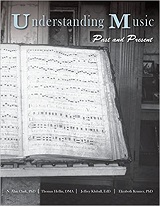
|
FreeComputerBooks.com
Links to Free Computer, Mathematics, Technical Books all over the World
|
|
- Title: Understanding Music: Past and Present
- Author/Editor(s) N. Alan Clark (Author), Thomas Heflin (Author), Jeffrey Kluball (Author)
- Publisher: University System of Georgia (USG); eBook (Creative Commons Licensed)
- License(s): CC BY-SA 4.0
- Hardcover/Paperback: 316 pages
- eBook: HTML and PDF
- Language: English
- ISBN-10: 1940771331
- ISBN-13: 978-1940771335
- Share This:

|
The benefits of music in our lives are increasingly acknowledged by researchers and scientist. As human beings, we have taken the existence of music for granted and rarely think critically about music and its purpose. Perhaps for this reason, such critical thinking about music is sometimes perceived as difficult.
Understanding Music: Past and Present is an open Music Appreciation textbook co-authored by music faculty across Georgia. The text covers the fundamentals of music and the physics of sound, an exploration of music from the Middle Ages to the present day, and a final chapter on popular music in the United States.
This book creates a roadmap from some of the earliest known origins of music to modern day. This linear approach allows the reader to trace the history and evolution of music through the ages. It is designed to grow the reader's appreciation of music through improved understanding and listening skills, allowing the reader to develop his or her own informed opinions and express them.
About the Authors- Pamela Sachant, University of North Georgia
- Peggy Blood, Savannah State University
- Jeffery LeMieux, College of Coastal Georgia
- Rita Tekippe, University of West Georgia
- Art, Music, and Related Books
- Computer, Digital, and Electronic Music
- Miscellaneous and Uncategorized Books

- Understanding Music: Past and Present (N. Alan Clark, et al.)
- The Mirror Site (1) - HTML and PDF
- The Mirror Site (2) - PDF
-
 Sound Reasoning (Anthony Brandt, et al.)
Sound Reasoning (Anthony Brandt, et al.)
Music is designed to express itself completely in sound. No matter what your knowledge or training, you should be able to enjoy music with the fullness of your thoughts, should be able to explore and interpret it with confidence.
-
 Understanding Basic Music Theory (Catherine Schmidt-Jones)
Understanding Basic Music Theory (Catherine Schmidt-Jones)
The main purpose of the book is to explore basic music theory so thoroughly that the interested student will then be able to easily pick up whatever further theory is wanted. Music history and the physics of sound are included.
-
 Reading Music: Common Notation (Catherine Schmidt-Jones)
Reading Music: Common Notation (Catherine Schmidt-Jones)
Generously illustrated and concise, this book is essential to any musician looking for a handy reference for the correct notation of music. A most welcome and beneficial source for every musician, whether using a pencil or a computer.
-
 A Quick and Dirty Guide to Art, Music, and Culture (Clayton Funk)
A Quick and Dirty Guide to Art, Music, and Culture (Clayton Funk)
This is a guidebook to a web resource of Artist and Musician biographies. You will see relationships between art and music and what you are learning and the way you live, to connect them to your own experience.
-
 Understanding New Media Art (Elizabeth Bilyeu, et al)
Understanding New Media Art (Elizabeth Bilyeu, et al)
This is an introductory college art and art history courses that builds on scholarship in the field to propose a long historical context for the technologies and ideas related to New Media Art in the 21st century.
-
 Introduction to Art: Design, Context, and Meaning (P. J. Sachant)
Introduction to Art: Design, Context, and Meaning (P. J. Sachant)
This book offers a comprehensive introduction to the world of Art. It provides a new and free alternative to traditional textbooks, making it an invaluable resource in our modern age of technology and advancement.
-
 Music and Computers: A Theoretical and Historical Approach
Music and Computers: A Theoretical and Historical Approach
This book provides a resource and guide for those just beginning to look at the field of computer music, as well as for more advanced computer composers who might benefit from a fresh insight.
-
 Computer Music: Sound Science and Technology (Wikibooks)
Computer Music: Sound Science and Technology (Wikibooks)
This book is a comprehensive guide and reference that covers all aspects of computer music, including digital audio, synthesis techniques, signal processing, musical input devices, performance software, editing systems, algorithmic composition, MIDI, synthesizer architecture, system interconnection, and psychoacoustics.





